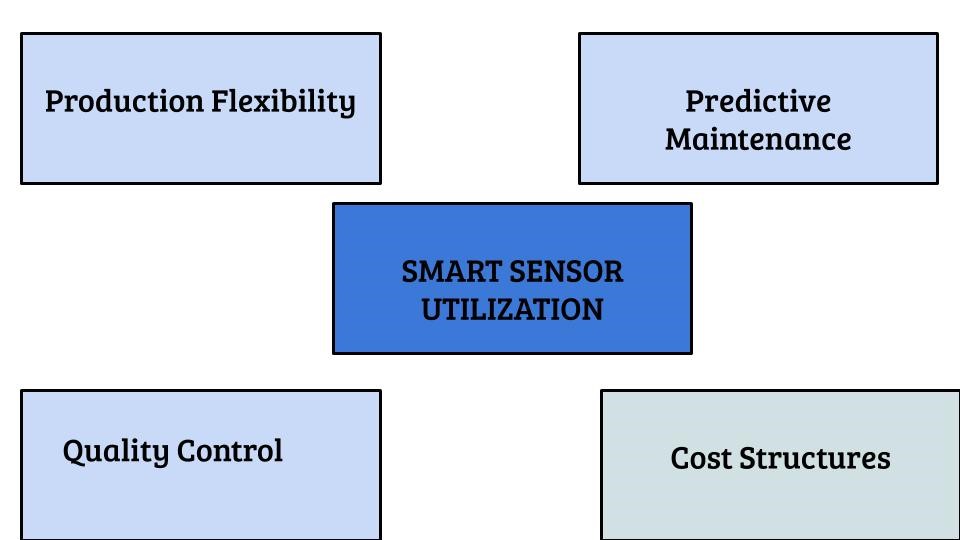
Industry 4.0 is an industrial phenomena that is changing the manufacturing landscape in a multitude of technically inspired ways. One such way is via the utilization of Smart Sensor Technologies. As the advent of the Industrial Internet of Things (IoT) emerges in the manufacturing realm, industrial processes are now less human controlled, and more machine controlled via process control technologies. What sensors allow us to do, is to generate industrial data, which can then be collated into process models that either plant control engineers, plant process engineers or reliability engineers can utilize to generate critical plant information for decision making. Some of the decisions that engineers make are:
- Is the unit operation performing according to target?
- Is the unit to be serviced?
- Is there room for more orders?
Industrial processes are always in need of ways via which they can address customers needs. With the appropriate sensor allocation throughout industrial processes, the generated data will facilitate continuous improvement and lean operational objectives. With new available insights, the organization will be able to keep itself on the peak of its performance.
With every visible opportunity capture, the company can then decide how it wants to maintain its operations and satisfy its cost requirements. What modern industrial facilities desire, is the ability to make fast decisions and maintain a reliable operating flow. Knowing the systems capability, will ensure that scheduling and production will be synchronized, with a minimal inventory in house.
On a global scale, many plant audits have indicated that industrial organizations are still not at their peak of smart sensor and process control utilization. With various factors, ranging from cost to expertize availability, organizations will have to strategically identify the means that they will take to implement the technology into their mainstream operations.
With appropriate planning, the desired competitive advantage will be attained. These gains will be via cost savings and best practice generations. Competitive advantage is a moving target, and organizations will have to ensure that they utilize all the critical personnel and tools necessary to achieve the target. To get a closer look on the advantages of smart sensor utilization, let us delve into four critical silos:
Business Enhancement Via Cost Savings:
Within an industrial process plant, sensors that track flows, temperatures, pressures, and other critical variables are always warranted. Within a system, it is always critical to know what is being generated by a system, and the resultant output of an industrial process. Processing utilizes the engineering of various parameters according to the desired output, and it will be critical to ensure that these process variables are being maintained as desired. In a heater system for instance, the critical variables to be monitored include: Inlet Temperature, Exit Temperature, U-Value Pressure Drop, Process Fluid Flow and number of days in service.
The value of having a sensor for each of these variables, will enable the facilitation of appropriate process monitoring that will facilitate cost savings. In the example of a heater given here, if a heater’s U-Value is traced and is found to be below target after a scheduled number of days, the maintenance staff can then clearly identify that the heater is to be taken from service and be washed.
Improved Employee Scheduling:
Continuous Processes often operate for twenty four hours a day, for the majority of the year, excluding those instances where there will be an extended overhaul period or a full plant shut down. During the operational calendar, knowing the exact equipment performance can facilitate the implementation of production flexibility and even worker responsiveness. With improved technology, Just-In-Time production flexibility in aspects of the operational calendar can then be facilitated.
Predictive Maintenance:
There are some critical expensive pieces of equipment that organizations may wish to keep running until the most critical moments of operation. These include boiler and turbine systems, that many organizations may have a need to ensure that uptime is maximized. Turbine downtime for instance, is a costly venture because it requires the purchasing of power to compensate for unit downtime.
Utilizing predictive maintenance tools to track critical parameters such as vibrations in the system, or bearing temperatures, will be one way that sensors can be utilized to forecast when maintenance will be needed. Knowing the level of expertise of the persons on the operational team, an appropriate schedule can be prepared for facilitating the critical changes.
Quality Control:
In all industries, satisfying the voice of the customer will be key to ensuring that the required process output is generated for one, and the appropriate internal resource management is being utilized. As much as possible, organizations do want to ensure that they are reducing their operational costs, minimizing re-work and re-processing. Critical process data that will aid the audit process for entities such as the ISO, can be accessed and generated from the sensor data available.
With a critical sensor baseline in place, organizations will not only be able to see the real-time performance of their processes, but be able to calculate suitable cost savings, make the appropriate changes, and improve their peak performance.
